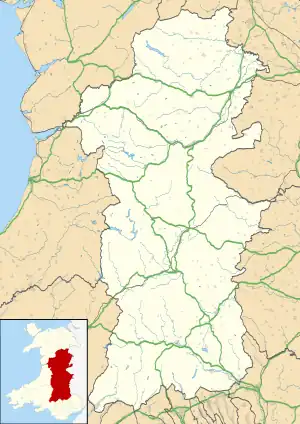Assembly Rooms, Presteigne
The Assembly Rooms in Presteigne (Welsh: Ystafelloedd Cynnull Llanandras), formerly Presteigne Town Hall (Welsh: Neuadd y Dref Llanandras), is a municipal building in Broad Street, Presteigne, Powys, Wales. The structure, which accommodates a public library on the ground floor and as an arts centre on the first floor, is a Grade II listed building.[1]
| The Assembly Rooms, Presteigne | |
|---|---|
| Native name Ystafelloedd Cynnull Llanandras | |
.jpg.webp) The Assembly Rooms, Presteigne | |
| Location | Broad Street, Presteigne |
| Coordinates | 52.2734°N 3.0064°W |
| Built | 1865 |
| Architect | Thomas Nicholson |
| Architectural style(s) | Italianate style |
Listed Building – Grade II | |
| Official name | Market Hall |
| Designated | 26 March 1985 |
| Reference no. | 8852 |
 Shown in Powys | |
History
In the early 1860s, a group of local businessmen led by the local member of parliament, Sir Richard Green-Price, whose seat was at Norton Manor, decided to form a company known as the "Presteigne Market Hall & Public Room Company" to finance and erect a new municipal building for the town:[2] the site they selected in Broad Street[lower-alpha 1] had been occupied by the local post office and, before that, by the Black Lion Inn.[4]
The foundation stone for the new building was laid by Lady Mary Jones-Brydges on 23 October 1863.[5] It was designed by Thomas Nicholson of Hereford in the Italianate style, built in red brick with stone finishings and the market hall was officially opened to the public on 1 November 1865.[5][6] The design involved an asymmetrical main frontage with four bays facing onto Broad Street; the left hand bay, which slightly projected forward, took the form of a three-stage clock tower with a doorway with a moulded segmental architrave in the first stage, a lancet window in the second stage and clock faces with ornamental stone surrounds in the third stage, all surmounted by a pyramid-shaped roof and a weather vane. The other three bays contained openings with voussoirs on the ground floor and round headed windows with voussoirs on the first floor. There were three bays finished in a similar style in Hereford Street and, at roof level, there was a wide cornice supported by brackets. Internally, the principal rooms were the market hall on the ground floor and the assembly rooms on the first floor.[1]
In the early years of the life of the building, the assembly rooms were used for petty session hearings and the building was referred to as the "Town Hall".[7] However, the company which had developed the building got into financial difficulty from an early stage and, in 1882, ownership passed to Elizabeth Abley who, as the principal lender, held a mortgage over the building.[8] The borough council, which had not met for many years, was abolished under the Municipal Corporations Act 1883.[9]
Following significant population growth, largely associated with the status of Presteigne as a market town, the area became an urban district in 1894.[10] The new urban district council acquired the building in 1903 and used the assembly rooms as council offices and, following a decline in use of the market, converted the former market hall for storage of the local horse-drawn fire engine.[11]
A cinema operated on the first floor of the building from 1934 until it closed in 1966.[12] The building subsequently accommodated a furniture shop and then, after a period of disuse, Mid Border Arts, which had been established in the Shire Hall in 1988, moved into the assembly rooms in 1992.[8] An extensive programme of refurbishment works costing £95,000, carried out with financial support from the Arts Council of Wales, was completed in 1995.[13] The works included fitting out the ground floor for use as a public library[14] and the first floor for use as an arts centre.[8]
Notes
- Broad Street, so called because of its significant width, had been the site of the medieval market.[3]
References
- Cadw. "Market Hall (8852)". National Historic Assets of Wales. Retrieved 15 June 2022.
- Presteigne Market Hall & Public Room Company share list, 1862-1866. Archives and Records Council Wales.
- "Historic Settlements Survey - Radnorshire : Presteigne" (PDF). Clwyd Powys Archaeological Trust. p. 4. Retrieved 15 June 2022.
- "Presteigne" (PDF). National Trail. Retrieved 15 June 2022.
- "Presteigne Market Hall (32138)". Coflein. RCAHMW. Retrieved 15 June 2022.
- Haslam, Richard (1979). Powys (Buildings of Wales Series). Yale University Press. p. 64. ISBN 978-0300096316.
- Howse, William Henry (1945). Presteigne, Past and Present. Jakemans. p. 57.
The Market Hall stood on the site of the present assembly rooms. There was a public room above, which was probably used as the Town Hall (referred to several times in the old Sessional Minutes).
- "History of Mid Border Arts". Retrieved 15 June 2022.
- Municipal Corporations Act 1883 (46 & 46 Vict. Ch. 18) (PDF). 1883. Retrieved 26 March 2023.
- "Presteigne UD". Vision of Britain. Retrieved 15 June 2022.
- "The old Market Hall and Assembly Rooms". Victorian Powys. Retrieved 15 June 2022.
- "Mid Border Arts". Cinema Treasures. Retrieved 15 June 2022.
- "Mid Border Community Arts Ltd". Got Lottery. Retrieved 14 June 2022.
- "This week's pictures from the past". Shropshire Star. 17 October 2008. Retrieved 15 June 2022.